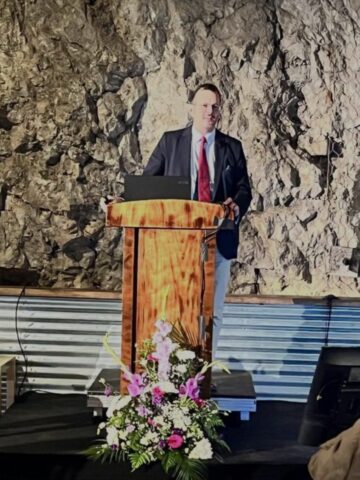The Calpe Conference 2025: A personal view Part Two
This is the second in a three-part series on this year’s Calpe Conference. Part three will be published tomorrow.
By Dr Alex Menez
The second day of the Calpe Conference began with a talk by Dr Gareth Stockey.
A historian of contemporary Spain and Gibraltar, he was Director of the International Consortium for the Study of Post-Conflict Cultures.
He noted that over the past twenty years, “a growing body of work has shed light on the important role that the British territory of Gibraltar played during the Spanish Civil War.”
Further understanding of the conflict and its aftermath, “an explosion of local and micro-histories have enormously enriched our knowledge.”
These relate to “the dynamics and legacies of political violence from the civil war period.”
Gareth noted that, “in some senses for Spaniards in the Campo, proximity to Gibraltar softened the worst aspects of the post-war years, not least the calamitous shortages that characterized… the hunger years” adding that, for many others, “proximity to Gibraltar, both geographically and symbolic, would only exacerbate the Franco regime’s repressive and re-educatory obsessions.”
Dr Lianne Tripp from Trent University, Canada, was a student of the late Professor Larry Sawchuk.
For many years, Larry and Lianne had researched demography (population studies), health, infectious diseases, and other topics.
In her presentation, she highlighted and described a range of Larry’s publications throughout his academic career.
Lianne has an interest “in the history of the unique population of the macaques in Gibraltar” having published a book with Larry in 2019, Monkey Tales - The Gibraltar macaque: A Living Legacy and a Perfect Nuisance.
Noting that the “origins and early history of the monkeys on the Rock of Gibraltar are murky,” she held that “interaction and dependency on humans, primarily the British military, was necessary for the survival of the monkeys on the Rock,” adding that “some have argued that the monkeys, the British, and the Rock are inseparable”.
Next was Dr Nicholas Marquez-Grant from Cranfield University.
He is one of eight chartered forensic anthropologists in the UK and has over twenty-five years of “experience recovering and analyzing human skeletal remains from prehistory to the present day.”
He explained that the search, recovery, and identification of military and civilian casualties from conflict relies increasingly on disciplines such as archaeology and biological anthropology.
Since the 1980s and 1990s, the “use of archaeological methods and practice as well as the analysis of human skeletal remains applied to a medico-legal, humanitarian or human rights context, have played a pivotal role,” this including DNA analysis.
Some governments, he noted, employ professionals “to search for their war dead,” describing how “these disciplines have helped to identify WWI and WWII casualties, in particular in Europe.”
Following lunch, the next presentation was by Professor Mina Weinstein-Evron, former head of the Zinman Institute of Archaeology, University of Haifa, and excavation director and co-director of Mount Carmel Caves Projects.
Mina explained that, during WWII “some 40,000 Palestinian Jews, both men and women, served in the British Army” from Greece and Crete, to North Africa and Iraq.
In 1944, the Jewish Infantry Brigade was “formed within the British Eighth Army.”
The Brigade symbolized “the culmination of efforts to secure Jewish representation in the Allied war effort, particularly as awareness of the fate of European Jews deepened.”
In late 1944, the Brigade was deployed to Italy and “fought along the Senio River, proudly displaying the Star of David on their uniforms and flags.”
Next on was Professor Julio Ponce Alberca from the University of Seville.
He spoke of “Gibraltar at the crossroads of WWII,” explaining that “the first is the geographical crossroads, given its strategic situation as a crucial crossway for the Royal Navy and its projection to land through the Air Force and Army.”
He noted that “it also served as a fortress, given its solidity as a Rock,” and that, secondly, Gibraltar “was the juncture of different interests from nation states placed in varied relative positions in the frame of the international landscape.”
There was also a “social crossroad,” a composition of “Gibraltarians, metropolitan population deployed temporarily,” people from other nationalities, and Spaniards in continuous contact with Gibraltar.
Julio explained that Gibraltar “became an outstanding platform for refugees and spies during periods of crisis such as the Spanish Civil War.”
All these crossroads, he noted, “met during the WWII years.”

The final talk of the day was by Professor Matthias Strohn, Head of the Historical Analysis Programme at the Centre for Historical Analysis and Conflict Research, the strategic think-tank for the British Army.
He holds a commission in the German Army, and with the rank of Colonel, serves as the head of the German military delegation in the UK.
He explained that, during WWII, “Gibraltar controlled a strategic position,” this “was known to both sides, and the Axis powers developed several plans to neutralize the Rock and the strategic threat it posed.”
He provided a detailed analysis of the political and military preparations “that were made by Germany and her allies for an attack on Gibraltar.”
As Matthias spoke of “the most famous invasion plan, Operation Felix,” contemplating and describing what might have “been the strategic consequences of a successful invasion of the Rock;” and would the Second World War had developed differently if Gibraltar had been seized by the Axis, I myself, and others I thought, contemplated that had the plan been successful, none of us would have been enjoying our Calpe Conference in the World War II Tunnels at Hays Level.









